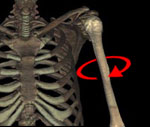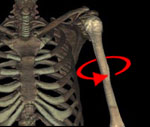The bony structures and 4 articulations of the shoulder described in the first lesson form the suspensory link for the attachment of the upper extremity to the trunk. The muscles that act on these bony structures produce the most dynamic and mobile joint in the body. The minimal bony constraints allow a wide range of motion at the expense of joint stability, which is augmented dynamically by the stablilizer muscles and ligaments. Shoulder mobility is produced by complex interactions of the functional groups of the shoulder for Abduction, Flexion, Adduction, Extension, Internal Rotation, External Rotation and Scapulothoracic Motion.
There are Extrinsic and Intrinsic shoulder muscles, defined by the origin of the muscles.
-
8 Extrinsic Shoulder MusclesThese arise from the axial skeleton and insert on the Shoulder Girdle or Humerus.
- Anterior Extrinsic muscles: Pectoralis Major and Pectoralis Minor
- Posterior Extrinsic muscles: Trapezius, Latissimus Dorsi, Serratus Anterior (see the Dissection Window to the right) and three deeper muscles: Levator Scapulae, Rhomboid Minor, and Rhomboid Major (click here to see a labeled image of the deep muscles)
-
6 Intrinsic Shoulder MusclesThese arise from the Shoulder Girdle and insert on the medial or lateral aspect of the Humerus.
- Medial Insertions: Subscapularis, and Teres Major
- Lateral Insertions: Supraspinatus, Infraspinatus, Teres Minor, and Deltoid
The shoulder muscles are innervated by nerves C4 through T1 and the Spinal Accessory Nerve (Trapezius).
Contraction of a primary agonist (the 'mover') moves the arm at the Glenohumeral Joint, but also generates a dislocating force that threatens joint stability. Generation of such a force requires activation of an antagonist muscle or muscles to prevent dislocation. This is referred to as a force couple for dynamic stability and a wide range of motion.
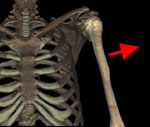
Abductors move the arm away from the side of the torso laterally in the coronal plane. The Humerus can abduct up to 120 degrees (the remaining motion to elevate the arm overhead comes from 60 degrees of Scapular rotation).
-
Supraspinatus
- Originates from the Supraspinatus Fossa of the Scapula, passes laterally under the Acromion and the Coricoacromial Ligament to form a broad tendon that inserts into the Shoulder Joint Capsule and the Greater Tuberosity of the proximal Humerus.
- Provides the first 30° of abduction of the Humerus.
- Forms the upper part of the Rotator Cuff.
-
Deltoid
-
The Deltoid is a multipennate muscle with 3 large components from 3 different origins and 3 different functions. The three components merge and insert on the lateral aspect of the mid-shaft of the Humerus at the Deltoid Tuberosity.
- The Anterior Deltoid (Clavicular part) arises anteriorly from the lateral third of the Clavicle.
- The Mid-Deltoid (Acromial Part) arises laterally from the Acromion.
- The Posterior Deltoid (Spinal Part) arises from the Scapular Spine.
- The Mid-Deltoid (Acromial Part) is the major shoulder abductor.
-
The Deltoid is a multipennate muscle with 3 large components from 3 different origins and 3 different functions. The three components merge and insert on the lateral aspect of the mid-shaft of the Humerus at the Deltoid Tuberosity.
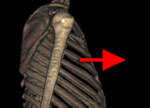
Flexors move the arm in front of the torso in the sagittal plane (aka Anteversion).
-
Coracobrachialis
- Originates on the Coracoid Process and inserts on the medial aspect of the mid-shaft of the Humerus.
-
Biceps Brachii
- Biceps Brachii Short Head originates at the Coracoid Process of the Scapula.
- Biceps Brachii Long Head originates at the Supraglenoid Tubercle of the Scapula, lies within the Glenohumeral Joint and descends between the Greater and Lesser Tuberosities of the Humerus.
- The two heads merge and insert on the Bicipital Tuberosity of the Radius.
- The Biceps Brachii crosses two joints and functions to flex the Humerus and to flex and supinate the forearm.
-
Pectoralis Major Clavicular Head
- Originates from the medial third of the Clavicle and inserts on the Intertubercular Groove of the Humerus.
-
Anterior Deltoid (Clavicular Part)
- Originates from the Acromion and inserts on the lateral aspect of the mid-shaft of the Humerus.
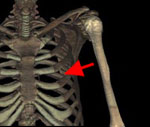
Adductors bring the arm in close to the torso. Adduction of the arm is produced by contraction of both anterior and posterior muscles.
-
Anterior Adductors:
-
Coracobrachialis
- Originates on the Coracoid Process and inserts on the Humerus.
-
Pectoralis Major
-
Pectoralis Major Clavicular Head
- Originates on the medial third of the Clavicle.
-
Pectoralis Major Sternocostal Head
- Originates from the Manubrium, Sternum, and upper Costal Cartilage, then it merges and inserts on the Intertubercular Groove of the Humerus.
-
Pectoralis Major Clavicular Head
-
Anterior Deltoid (Clavicular Part)
- Originates from lateral aspect of the Clavicle and inserts on the Humerus.
-
Coracobrachialis
-
Posterior Adductors:
-
Latissimus Dorsi
- (The largest muscle in humans.) Originates from the posterior aspect of the back from T6 to the Iliac Crest in four parts (Vertebral, Iliac, Costal and Scapular parts) and inserts with Teres Major on the crest of the Lesser Tubercle of the medial Humerus.
-
Teres Major
- Originates on the Scapula and inserts on the Intertubercular Groove of the Humerus.
-
Long Head of the Triceps
- Originates from the Infraglenoid Tubercle of the Scapula so it crosses two joints and produces Extension at both the Shoulder and the Elbow.
-
Posterior Deltoid (Spinal Part)
- Arises from the Scapular Spine and inserts on the lateral aspect of the Humerus.
-
Latissimus Dorsi
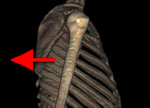
Extensors move the arm posteriorly behind the torso in the sagittal plane (aka Retroversion).
-
Latissimus Dorsi
- (The largest muscle in humans.) Originates from the posterior aspect of the back from T6 to the Iliac Crest in four parts (Vertebral, Iliac, Costal and Scapular parts) and inserts with Teres Major on the crest of the Lesser Tubercle of the medial Humerus.
-
Teres Major
- Originates on the Scapula and inserts on the Intertubercular Groove of the Humerus.
-
Triceps Brachii
-
The Triceps Brachii has three heads - the Long, Medial and Lateral heads. They merge and insert on the Olecranon of the Ulna and together function as the extensor at the Elbow.
- Triceps Brachii Long Head originates from the Infraglenoid Tubercle of the Scapula, so it crosses two joints and produces Extension at both the Shoulder and the Elbow.
- Triceps Brachii Medial Head originates at the Groove on the Humerus for the Radial Nerve.
- Triceps Brachii Lateral Head originates from the dorsal lateral surface of the Humerus.
-
The Triceps Brachii has three heads - the Long, Medial and Lateral heads. They merge and insert on the Olecranon of the Ulna and together function as the extensor at the Elbow.
-
Posterior Deltoid (Spinal Part)
- Arises from the Scapular Spine and inserts on the lateral aspect of the Humerus.
